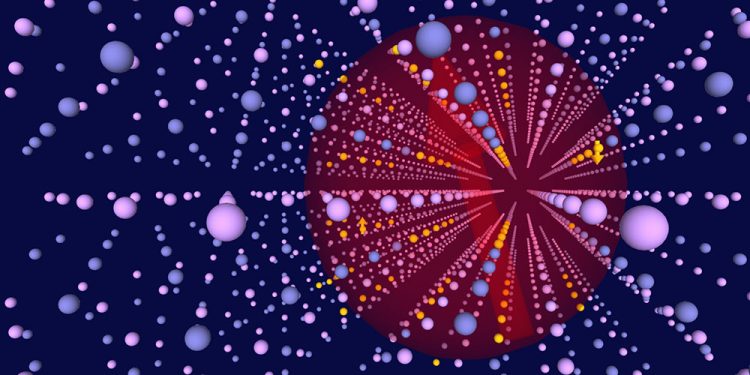Physicists Couple Distant Nuclear Spins Using a Single Electron

Art view of a semiconductor InAs/GaAs quantum dot (In, Ga and As respectively in yellow, blue and purple). Two remote nuclear spins (yellow arrows) are coupled via the spin of an electron delocalized over the quantum dot (red). (Image: University of Basel, Department of Physics)
In most materials, the nuclear spins of neighboring atoms have only a very weak effect on one another, as the tiny nuclei are located deep within the atoms. This is not the case in metals, however, where some of the electrons are able to move freely. The electron spins are able to couple nuclear spins at relatively large distances from one another. Named after four physicists, this RKKY interaction was discovered in the 1950s.
Nuclear spins linked by an individual electron spin
Now, an experiment by researchers from the Department of Physics at the University of Basel has for the first time succeeded in demonstrating this mechanism with a single electron, describing it using quantum theory. The team led by Prof. Richard Warburton trapped a single electron inside a quantum dot.
With use of a method developed in Basel to measure nuclear spin resonance, they showed that the electron coupled the spins of nuclei up to five nanometers apart – a huge distance in the world of nuclear spins. The results are particularly relevant to the development of spin qubits: these seek to use electron spins to carry information, but the interaction with the nuclei limits the stability of the quantum information.
Concentrated blast of physics
“This is probably the most complicated experiment our team has ever carried out,” says Prof. Richard Warburton, leader of the nano-photonics research group at the Department of Physics in Basel. At the same time, he expressed his delight at the cooperation between the three research groups that made this experiment possible. “There were so many different aspects to take into account – a challenge we were able to master only thanks to the fantastic collaborations in our department.”
The research group led by Prof. Martino Poggio provided the expertise in the field of nuclear spin resonance, while the team led by Prof. Daniel Loss spent months computing the quantum theory for the experiment. A vital contribution also came from Ruhr University Bochum, which manufactured the semiconductor chips for the experiment.
The project received funding from the National Center of Competence in Research Quantum Science and Technology (NCCR QSIT), the Swiss National Science Foundation and the Swiss Nanoscience Institute.
Original article
Gunter Wüst, Mathieu Munsch, Franziska Maier, Andreas V. Kuhlmann, Arne Ludwig, Andreas D. Wieck, Daniel Loss, Martino Poggio and Richard J. Warburton
Role of the electron spin in the nuclear spin coherence in a quantum dot
Nature Nanotechnology (2016), doi: 10.1038/nnano.2016.114
Further information
Prof. Dr. Richard J. Warburton, University of Basel, Department of Physics, tel. +41 61 267 35 60, email: richard.warburton@unibas.ch
Media Contact
More Information:
http://www.unibas.chAll latest news from the category: Physics and Astronomy
This area deals with the fundamental laws and building blocks of nature and how they interact, the properties and the behavior of matter, and research into space and time and their structures.
innovations-report provides in-depth reports and articles on subjects such as astrophysics, laser technologies, nuclear, quantum, particle and solid-state physics, nanotechnologies, planetary research and findings (Mars, Venus) and developments related to the Hubble Telescope.
Newest articles

Properties of new materials for microchips
… can now be measured well. Reseachers of Delft University of Technology demonstrated measuring performance properties of ultrathin silicon membranes. Making ever smaller and more powerful chips requires new ultrathin…

Floating solar’s potential
… to support sustainable development by addressing climate, water, and energy goals holistically. A new study published this week in Nature Energy raises the potential for floating solar photovoltaics (FPV)…

Skyrmions move at record speeds
… a step towards the computing of the future. An international research team led by scientists from the CNRS1 has discovered that the magnetic nanobubbles2 known as skyrmions can be…





















